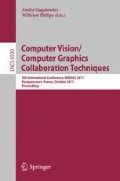Abstract
This paper presents a novel methodology based on joint histograms, for the automated and unsupervised segmentation of multiple sclerosis (MS) lesion in cranial magnetic resonance (MR) imaging. Our workflow is composed of three steps: locate the MS lesion region in the joint histogram, segment MS lesions, and false positive reduction. The advantage of our approach is that it can segment small lesions, does not require prior skull segmentation, and is robust with regard to noisy and inhomogeneous data. Validation on the BrainWeb simulator and real data demonstrates that our method has an accuracy comparable with other MS lesion segmentation methods.
Access this chapter
Tax calculation will be finalised at checkout
Purchases are for personal use only
Preview
Unable to display preview. Download preview PDF.
References
Grimaud, J., Lai, M., Thorpe, J., Adeleine, P., Wang, L., Barker, G.J., Plummer, D.L., Tofts, P.S., McDonald, W.I., Miller, D.H.: Quantification of MRI lesion load in multiple sclerosis: a comparison of three computer-assisted techniques. Magnetic Resonance Imaging 14, 495–505 (1996)
Rouaïnia, M., Medjram, M.S., Doghmane, N.: Brain MRI segmentation and lesions detection by EM algorithm. World Academy of Science. Engineering and Technology 24, 139–142 (2006)
Sajja, B.R., Datta, S., He, R., Mehta, M., Gupta, R.K., Wolinsky, J.S., Narayana, P.A.: Unified approach for multiple sclerosis lesion segmentation on brain MRI. Annales of Biomedical Engineering 34(1), 142–151 (2006)
Shiee, N., Bazin, P.L., Pham, D.L.: Multiple Sclerosis Lesion segmentation using statistical and topological atlases. In: Medical Image Analysis on Multiple Sclerosis(MIAMS) Workshop in MICCAI (2008)
Dugas-Phocion, G., Gonzalez, M.A., Lebrun, C., Chanalet, S., Bensa, C., Malandain, G., Ayache, N.: Hierarchical segmentation of multiple sclerosis lesions in multi-sequence MRI. Biomedical Imaging: Nano to Macro (2004)
Leemput, K.V., Maes, F., Vandermeulen, D., Colchester, A., Suetens, P.: Automated segmentation of multiple sclerosis lesions by model outlier detection. IEEE Transactions on Medical Imaging 20(8), 677–688 (2001)
Aït-Ali, L.S., Prima, S., Hellier, P., Carsin, B., Edan, G., Barillot, C.: STREM: A robust multidimensional parametric method to segment MS lesions in MRI. In: Duncan, J.S., Gerig, G. (eds.) MICCAI 2005. LNCS, vol. 3749, pp. 409–416. Springer, Heidelberg (2005)
Iannucci, G., Minicucci, L., Rodegher, M., Sormani, M.P., Comi, G., Filippi, M.: Correlations between clinical and MRI involvement in multiole sclerosis assessment using T1, T2 and MT histograms. Journal of the Neurological Sciences 171, 121–129 (1999)
Wang, W.H., Feng, Q.J., Liu, L., Chen, W.F.: Segmentation of brain MR images through class-adaptive Gauss-Markov random field model and the EM algorithm. Journal of Image and Graphics 13(3), 488–493 (2008)
Li, C.M., Kao, C.Y., John, C., Ding, Z.H.: Minimization of Region-Scalable Fitting Energy for Image Segmentation. IEEE Trans. Image Processing 17(10), 1940–1949 (2008)
Chan, T.F., Esedoglu, S., Nikolova, M.: Algorithms for finding global minimizers of denoising and segmentation models. SIAM Journal on Applied Mathematics 66, 1632–1648 (2006)
Goldstein, T., Bresson, X., Osher, S.: Geometric Applications of the Split Bregman Method: Segmentation and Surface Reconstruction. Journal of Scientific Computing 45, 272–293 (2010)
Wang, W.H., Feng, Q.J., Chen, W.F.: Active contour based on Region-scalable fitting energy. To be Presented at Chinese Journal of Computers (2011)
Bresson, X., Esedoglu, S., Vandergheynst, P., Thiran, J., Osher, S.: Fast Global Minimization of the Active Contour/Snake Model. Journal of Mathematical Imaging and Vision 28, 151–167 (2007)
Yang, Y.Y., Li, C.M., Kao, C.Y., Osher, S.: Split Bregman Method for Minimization of Region-Scalable Fitting Energy for Image Segmentation. In: Bebis, G., Boyle, R., Parvin, B., Koracin, D., Chung, R., Hammound, R., Hussain, M., Kar-Han, T., Crawfis, R., Thalmann, D., Kao, D., Avila, L. (eds.) ISVC 2010. LNCS, vol. 6454, pp. 117–128. Springer, Heidelberg (2010)
Brain Web. Montreal Neurological Institute, McGill University (2006), http://www.bic.mni.mcgill.ca/brainweb/
spm99 (2000), http://www.fil.ion.ucl.ac.uk/spm/
Author information
Authors and Affiliations
Editor information
Editors and Affiliations
Rights and permissions
Copyright information
© 2011 Springer-Verlag Berlin Heidelberg
About this paper
Cite this paper
Zeng, Z., Zwiggelaar, R. (2011). Joint Histogram Modelling for Segmentation Multiple Sclerosis Lesions. In: Gagalowicz, A., Philips, W. (eds) Computer Vision/Computer Graphics Collaboration Techniques. MIRAGE 2011. Lecture Notes in Computer Science, vol 6930. Springer, Berlin, Heidelberg. https://doi.org/10.1007/978-3-642-24136-9_12
Download citation
DOI: https://doi.org/10.1007/978-3-642-24136-9_12
Publisher Name: Springer, Berlin, Heidelberg
Print ISBN: 978-3-642-24135-2
Online ISBN: 978-3-642-24136-9
eBook Packages: Computer ScienceComputer Science (R0)

